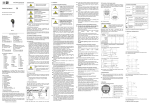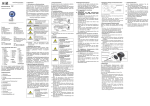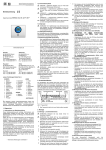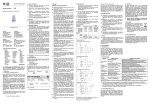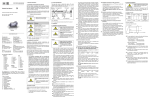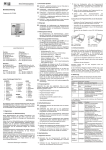Download EN Original User Manual Warning term DANGER
Transcript
1.4 Limitation of liability and warranty EN - Failure to follow the instructions or observe technical regulations, improper use or use of the device in a manner other than that intended, or alteration or damage to the device will void the warranty and invalidate claims for liability. Original User Manual 1.5 Intended use - The Pressure transmitters DCT 531 with Modbus RTU communication interface 485 respectively the pressure transmitters DCT 532 with i²C interface have been developed for pressure measuring applications depending on the particular model. Depending on the particular device and mechanical connection, they are suitable for a wide range of applications. The pressure sensor is intended for installation in a machine or system. It is the responsibility of the user to check whether the device is suitable for the chosen application. If in doubt, please contact our sales office. BD SENSORS cannot, however, assume any liability for an incorrect choice or any consequences arising from this! Pressure transmitter with RS485 Modbus RTU / i²C interface DCT 531, DCT 532 - Media that can be measured are gases or liquids that are compatible with the materials that contact the medium. These are described in the data sheet. Furthermore, it must be ensured in each individual case that the medium is compatible with the parts the come in contact with it. www.bdsensors.com Russia BD SENSORS RUS 39a, Varshavskoe shosse RU - Moscow 117105 Russia Tel.: +7 (0) 95-380 1683 Fax: +7 (0) 95-380 1681 Eastern Europe BD SENSORS s.r.o. Hradištská 817 CZ - 687 08 Buchlovice Czech Republic Tel.: +42 (0) 572-4110 11 Fax: +42 (0) 572-4114 97 China BD SENSORS China Co, Ltd. Room B, 2nd Floor, Building 10, No. 1188 Lianhang Rd. 201112 Shanghai, China Tel.: +86 (0) 21-51600 190 Fax: +86 (0) 21-33600 613 - - - - The technical data as set out in the current data sheet are authoritative. If you do not have the data sheet, please request it from us or download it from our website. DCT 532 Headquarters BD SENSORS GmbH BD-Sensors-Str. 1 D - 95199 Thierstein Germany Tel.: +49 (0) 9235-9811-0 Fax: +49 (0) 9235-9811-11 - WARNING Danger of death through incorrect use - In order to avoid accidents, use the device only in accordance with its intended use. 1.6 Package contents Check that all of the listed parts are included in the delivered package and have been supplied in accordance with your order: - Pressure transmitters from the DCT 531 / DCT 532 series - For DIN 3852 mech. connectors: O-ring (pre-fitted) - User manual - 2. Product Identification The type plate serves to identify the device. The most important data can be taken from this. The order code is used for unique identification of your product. - - 1. General Information Measure- Type designation ment range Order code Serial number 1.1 Information concerning the user manual Follow the safety and handling instructions that are set out in this user manual. Compliance with the applicable accident prevention regulations and safety regulations as well as with national installation standards and recognized codes of practice must also be ensured. This user manual is part of the device and should be kept accessible to personnel at all times in the immediate vicinity of the installation location of the device. – Subject to technical alteration – Signal Supply Fig. 1 Type plate The type plate must not be removed from the device! 1.2 Symbols used - Nature and source of danger Measures to prevent danger 3. Installation 3.1 Installation and safety instructions Warning term Warning term DANGER WARNING CAUTION Pin configuration Danger of death from electric shock Meaning DANGER Immediate danger! Failure to observe will result in death or serious injury. Danger of death from improper installation Possible danger! Failure to observe may result in death or serious injury. Dangerous situation! Failure to observe may result in slight or moderate injury. WARNING Please note that the entire system must comply with the requirements of the BAM (German Federal Institute for Materials Research and Testing, DIN 19247). Pressure transmitters designed for use without seals are recommended for oxygen applications > 25 bar. Pressure transmitters with 70 EPDM 281 sealing rings: Maximum permitted values: 15 bar / 60° C and 10 bar / 60° C to 90° C (BAM approval). Pressure transmitters with FKM (Vi 567) sealing rings: Maximum permitted values: 25 bar / 150° C (BAM approval). Please treat this highly sensitive electronic measuring instrument carefully, both when packed and when unpacked! No modifications or alterations may be made to the device. Do not throw or drop the device! Only remove the packaging and, if applicable, the protective cap from the device shortly before its installation, so as to avoid damaging the diaphragm. Be sure to retain the supplied protective cap! Fit the protective cap back over the diaphragm immediately after dismounting the device. Treat the unprotected diaphragm with extreme care; it can be damaged very easily. Do not apply any force to install the device so as to avoid damaging the device and the system! When installing outdoors or in humid environments, the following points should be noted: The device should be electrically connected immediately after installation to ensure that no moisture is able to penetrate into the plug connector, If this is not possible, the ingress of moisture must be prevented by using a suitable protective cap. (The protection class specified in the data sheet applies to the connected device.) Select an installation position that allows splashed water and condensation to drain away. Ensure that sealing surfaces are not exposed to standing liquid! Install the device such that it is protected from direct sunlight. In the worst case, direct sunlight may result in the maximum permissible operating temperature being exceeded, which can then damage the device or affect its ability to function correctly. If the internal pressure in the device rises, this could also cause temporary measurement errors. Take care that the pressure connector is not subjected to any mechanical stresses higher than that permitted, since this could cause the characteristic to shift or result in damage. This applies especially to very small pressure ranges, as well as to devices with a pressure connector made of plastic. In the case of hydraulic systems, orient the device such that the pressure connector faces upwards (for venting). Provide a cooling section when using the device in steam lines. If there is a risk that a device installed outdoors might be damaged by lightning strike or overvoltage, we recommend the provision of overvoltage protection between the power supply unit or control cabinet and the device. If the device is installed with the pressure connector facing upwards, make sure that no liquid runs down the housing. This could result in moisture and dirt blocking the gauge reference in the housing and cause malfunctions. If necessary, remove any dust and dirt from the edge of the screw joint of the electrical connector. 3.3 Installation instructions for DIN 3852 connectors - - - DO NOT USE ANY ADDITIONAL SEALING MATERIALS SUCH AS TOW, HEMP OR TEFLON TAPE! Check that the O-ring is undamaged and is seated in the groove provided for it. Make sure that the sealing surface of the receiving part is perfectly clean and smooth. (RZ 6,3) Screw the device into the mounting thread by hand. If you have a device with a knurled ring, the device need only be screwed in by hand. Devices with wrench flats must be tightened with an open-end wrench (with steel wrench flats: G1/4": approx. 5 Nm; G1/2": approx. 10 Nm; G3/4": approx. 15 Nm; G1": approx. 20 Nm; with plastic wrench flats: max. 3 Nm). The specified tightening torques must not be exceeded! DANGER - Danger of death from explosion through improper use of devices intended for use with oxygen - The following points must be observed in order to ensure safe handling: Make sure that a special version of your device has been ordered for use with oxygen and that the expected device has been delivered. The easiest way for you to verify this is by checking the type plate (see Fig. 1 regarding this). If your order code ends with the digits "007", then your device is suitable for oxygen applications. Map of Input registers (read only, function #4 - Read Input Registers) Connection diagrams: Adress RS 485 / Modbus RTU Supply + p VS = 9 ... 32 VDC Supply - 0x0005 0x0006 0x0007 - Check that the O-ring is undamaged and is seated in the groove provided for it in the receiving fitting. - Center the dairy pipe connector in the corresponding receiving fitting. - Screw the union nut on to the receiving fitting. - Then pull it tight with a hook wrench. 3.7 Installation instructions for clamp and Varivent connectors - Use a suitable seal that is compatible with the process medium and the pressure to be measured. - Place the seal on the corresponding receiving fitting. - Center the clamp or Varivent connector above the corresponding receiving fitting with its seal. - Then attach the device using a suitable fastening element (e.g. semi-ring or retractable ring clamp) in accordance with the manufacturer's instructions. The sensor must not be exposed to high temperatures or rapid pressure increases that exceed the specified limits (see data sheet for limit values). The sensitive diaphragm of the flush-mounted sensor must not be touched since it may deform or tear. 4. Electrical Installation WARNING Danger of death from electric shock - Switch off the power supply before installing the device. Electrically connect the device in accordance with the specifications given on the type plate, the following pin assignment table and the connection diagram. Interface Electrical connections RS 485 Modbus RTU Supply + Supply – Not inverted B+ inverted A- Interface Electrical connections I²C Supply+ Supply – SDA SCL INT Shielding M12x1 (4-pin) metal 1 3 2 4 Binder 723 (5-pin) 1 3 2 4 Pressure port 5 M12x1 (5-pin metal 1 3 2 4 5 Binder 723 (5-pin) 1 3 2 4 5 housing housing Cable colours (DIN 47100) wh (white) bn (brown) gn (green) ye (yellow) ye/gn (yellow / green) Cable colours (DIN 47100) wh (white) bn (brown) ye (yellow) gn (green) pk (pink) ye/gn ( yellow / green ) Date Upper range of pressure channel Float, IEEE754 Lower range of pressure channel Float, IEEE754 Actual pressure Float, IEEE754 Maximal Pressure Float, IEEE754 Minimal Pressure Float, IEEE754 Upper range of temperature channel Float, IEEE754 Lower range of temperature channel Float, IEEE754 Actual temperature Float, IEEE754 Maximal temperature Float, IEEE754 Minimal temperature Float, IEEE754 0x0008 0x0009 I²C 0x000A 0x000B 0x000D 3.6 Installation instructions for dairy pipe connectors Date of last calibration 0x0002 0x0004 A (-) RS485 UInt32 0x0003 B (-) 0x000E 0x000F 0x0010 0x0011 0x0012 0x0013 For the installation of a device with cable outlet following bending radiuses have to be complied with: cable without ventilation tube: static installation : 5-fold cable diameter dynamic application: 10-fold cable diameter Data type Serial Number 0x0001 0x000C - Additional seal materials, e.g. PTFE tape, may be used to provide sealing. - Screw the device into the mounting thread by hand. - Then tighten it with the open-end wrench (for 1/4" NPT: approx. 30 Nm; for 1/2" NPT: approx. 70 Nm). - The specified tightening torques must not be exceeded! Register 0x0000 - Use a suitable seal that is compatible with the process medium and the pressure to be measured (e.g. a copper seal). - Make sure that the sealing surface of the receiving part is perfectly clean and smooth. (RZ 6,3) - Screw the device into the mounting thread by hand. - Then tighten it with the open-end wrench (for G1/4": approx. 20 Nm; for G1/2": approx. 50 Nm). - The specified tightening torques must not be exceeded! 3.5 Installation instructions for NPT connectors 3.2 General installation instructions - Carefully remove the device from its packaging and dispose of the packaging properly. - Then proceed as described in the following installation instructions. 6.2 Explicit register description Pin assignment table: 3.4 Installation instructions for EN 837 connectors Shielding 1.3 Qualification of personnel Work on electrical components must be performed only by a qualified electrician and in accordance with the applicable regulations and guidelines. - Installation must be performed only by appropriately qualified specialist personnel who have read and understood the user manual. Oxygen NOTE – Tips and information for the user in order to ensure trouble-free operation. Installation, commissioning, operation, maintenance, decommissioning and disposal may be carried out only by appropriately qualified specialist personnel. - Install the device only when the machine is depressurized and the power supply has been switched off! When it is delivered, the device is packaged in a plastic bag to protect it from contamination. Take note of the advice sticker with the text "Device for oxygen; unpack immediately before installation"! Also note that contact with skin should be avoided when unpacking and installing the device so as to avoid leaving grease residues on the device. The relevant provisions concerning explosion protection must be met during installation. Also check whether approval as intrinsically safe equipment is required in addition to suitability for oxygen. (This is not the case for the device as supplied!) 0x0014 0x0015 0x0016 0x0017 cable with ventilation tube: static installation : 10-fold cable diameter dynamic application: 20-fold cable diameter Map of Holding registers (read, write, fce #3 - Read Holding Registers , fce #6 - Write Single Register) the damage or removal of the PTFE filter which is fixed over the end of the air tube on devices with cable outlet and integrated air tube. 0x0000 Unit of pressure channel Uint16 0x0001 Unit of temperature channel Uint16 0x0002 Device address Uint16 0x0003 Baud rate Uint16 0x0004 Parity Uint16 If possible, use a shielded and twisted multicore cable for the electrical connection. If a transition is desired from a transmitter cable with gauge tube to a cable without gauge tube, we recommend our terminal box KL 1 or KL 2. 5. Commissioning Adress Register (description) Data type Pressure unit enumeration Code (Uint16) Unit Before using the device for the first time, check that it has been properly installed, and make sure that it does not show any visible defects. 0x0003 mmH2O 0x0004 mmHG 0x0005 psi The device may by commissioned only by appropriately qualified specialist personnel who have read and understood the user manual. 0x0006 bar 0x0007 mbar 0x0008 g/cm² 6. Modbus RTU Communication 0x0009 kg/cm² 6.1 Configuration of Modbus RTU 0x000A Pa 0x000B kPa Factory setting address Baud-Rate 4800 9600 19200 38400 Paritate none odd even 1 1 1 1 … 247 0 1 2 3 0x000C torr 0x000D atm 0x000E mH2O 0x000F MPa Temperature unit enumeration Code (Uint16) 0 1 2 Unit 0x0000 °C 0x0001 °K 0x0002 °F Baud rate enumeration Code (Uint16) Baud rate [Bd] 0x0004 4800 0x0005 9600 0x0006 19200 0x0007 38400 Parity enumeration Code (Uint16) 0x0000 Parity none 0x0001 odd 0x0002 even 7. i²C-Interface 7.3 Explicit register description 7.1 Configuration of i²C-Interface Explanation: r = only readable r/w = read and write capable d = don´t care Standard 050 0 0 0 0 00001 Slave address address 1 … 127 7 32bit IEEE float 6 1 r Low byte first 0 High byte first 1 Mode of result register bit 0 Value 0 Percent of nominal 1 Restore of address pointer no restore 0 to last set address on next start 1 d Count of result 00001 … 10000 3 SAT 5 d d 4 3 2 RESTORE MODE r/w r/w 1 0 7 6 5 4 ORDER TYPE r/w 3 2 1 Danger of injury from media escaping under pressure 0 UNIT r/w 2 1 0 Type 0 (Float) Status Mode 1 (Int 16) bit 2 d r TYPE of result register bit 0 r/w WARNING r r r r 1b= Registers contain new values Note: This bit has same behaviour as hardware ready connector. Logic level is inverted because of open collector at output stage. 0b= 32bit IEEE float 1b= 16bit integer Pressure UNIT (according to units in HART protocol) bit 0…7 OVER UNDER READY Outdated values will be read Note: 0x01 0x02 0x03 0x04 0x05 0x06 0x07 0x08 0x09 0x0A 0x0B 0x0C 0x0D 0x0E 0x91 0xAA 0xAB 0xAC 0xAD 0xAE 0xB0 0xB1 0xB2 0xB3 0xED 0xEE 0xEF Byte ORDER of values bit 1 0b= Low byte first 1b= High byte first MODE of result register bit 2…3 It is possible to poll update without using hard wiring, or to check wich sensor has updatad if more than one is used on bus. Value is out of UNDER nominal range 00b= Value 01b= Percent of nominal 10b= reserved 11b= reserved Status RESTORE address pointer Pressure 0b= Pressure value is in nominal range bit 4 Temperature 1b= Pressure is to low 0b= No restore Note: OVER and UNDER flags are stored until state register is read. 1b= Restore to last set address on restart Note: Using this setting causes reset of register pointer to last written after each stop condition of readout. Pressure Temperature bit 3 0x40 0x41 0x42 0x43 0x44 0x45 0x46 0x47 0x48 0x49 0x4A 0x4B 0x4C 0x4D 0x4E 0x4F 0x50 0x51 0x52 0x53 0x54 0x55 4 ERR 0b= 7.3 Register overview 65 66 67 68 69 70 71 72 73 74 75 76 77 78 79 80 81 82 83 84 85 86 r/w Result registers is READY Digital meaning 0x00 0x01 0x02 0x03 0x04 0x05 0x06 0x07 0x08 5 ABS Byte order of values 1 2 3 4 5 6 7 8 9 6 ADD 0 16bit integer Register 7 8. Decommissioning 0x44 – Pressure unit register 0x00 – Status register: Type of result register Nr. 0x40 – Configuration register Configuration Configuration Oversampling Oversampling Slave Address Pressure unit Slave Address Pressure unit Nominal pressure lower Decimal places Nominal pressure lower Value SATurated 0b= No saturation 1b= Output value or ADC is out of range Set new I2C slave ADDress bit 7 Nominal pressure upper Temperature unit Nominal temperature lower Nominal temperature upper Temperature unit Nominal temperature lower Decimal places Nominal temperature upper bit 7 7 6 5 4 Internal ERRor, transmitter does not work 0b= Transmitter is in normal operation 1b= Internal error or wrong setting is active Transmitter is ABSolute 1b= Set this bit to apply previously set slave address 0x43 – Slave adress register 7 6 5 Pressure type of transmitter is relative Pressure type of transmitter is absolute - Depending on the measured medium, suitable precautions should be taken, e.g. protective gloves, goggles. 9. Maintenance The device is, in principle, maintenance free. If necessary, the housing of the device may be cleaned with a damp cloth and a non-aggressive cleaning solution while it is switched off. With certain media may, however, deposits or contamination may accumulate on the diaphragm. The specification of appropriate maintenance intervals for inspection.is recommended in this case. Once the device has been properly decommissioned, the diaphragm can normally be cleaned with a non-aggressive cleaning solution and a soft brush or sponge. Care should be taken while doing so. If the diaphragm is covered in limescale, decalcification by BD SENSORS is recommended. See the Servicing/Repair section with regard to this. Depending on the medium used, residues on the device may constitute a hazard to the environment. You should therefore take appropriate precautions if necessary and dispose of the device properly. 12. Guarantee Conditions The guarantee conditions are subject to the statutory warranty period of 24 months, starting from the date of dispatch. No warranty claims will be accepted if the device has been used improperly, modified or damaged. The warranty does not cover damaged diaphragms. Warranty cover also excludes any claims for defects that have arisen as a result of normal wear. 13. Declaration of Conformity / CE The supplied device fulfills the statutory requirements. The relevant directives, harmonized standards and documents are listed in the EU Declaration of Conformity applicable to the product. This can be found at http://www.bdsensors.de. In addition, the operational safety of the device is confirmed by the CE mark on the type plate. Incorrect cleaning can result in irreparable damage to the measuring cell. For this reason, you should never use sharp objects or compressed air to clean the diaphragm. 10. Servicing/Repair 10.1 Recalibration It is possible that the offset value or the scaling value may shift during the lifetime of the device. This is indicated by a deviation in the output signal value with reference to the set measurement range start or end values respectively. If either of these two phenomena should occur after a prolonged period of use, recalibration is recommended in order to ensure a continued high level of accuracy. 3 2 1 0 UNIT 4 r/w Temperature UNIT (according to units in HART protocol) bit 0…7 3 2 1 0 SLAVE_ADDRESS 0b= WARNING 0x4d – Temperature unit register Slave address stays as it is 1b= Nominal pressure upper Danger of injury from the measured medium The device must be disposed of in accordance with European Directives 2002/96/EC and 2003/108/EC (Waste Electrical and Electronic Equipment). Waste electrical products may not be disposed of with household waste! 10.2 Return 0b= bit 4 inH2O @ 68°F inHg @ 0°C ftH2O @ 68°F mmH2O @ 68°F mmHG @ 0°C psi bar mbar g/cm² kg/cm² Pa kPa Torr atm inH2O @ 60°F cmH2O @ 4°C mH2O @ 4°C cmHg @ 0°C lb/ft² hPa kg/m² ftH2O @ 4°C ftH2O @ 60°F mHg @ 0°C Mpa inH2O @ 4°C mmH2O @ 4°C - Dismount in an orderly fashion when the machine is depressurized and the power supply has been switched off. - Check whether the medium needs to be drained before dismounting! 11. Disposal r/w bit 1…7 d SLAVE ADDRESS which this transmitter acknowleges Note: To apply new address, it is necessary to set ADD bit in configuration register after new address is written. 0x20 0x21 0x22 0x23 °C °F °R K Note: If pressure or temperature unit is set to an invalid value, slave will not acknowledge. Note: Whenever the device is returned, no matter whether for recalibration, decalcification, modification or repair, it must be carefully cleaned and packed such that there is no risk of breakage. The device must be accompanied by a notice of return giving a detailed description of the fault. If your device has come into contact with pollutants, then a notice of decontamination will also be needed. You can find the relevant templates on our website at www.bdsensors.de. Should you send in your device without a notice of decontamination and doubts with regard to the medium used should arise in our service department, repair work will commence only once an appropriate notice has been received. Caution Danger of injury from pollutants - If the device has come into contact with pollutants, wear suitable protective clothing, e.g. gloves, goggles, when cleaning it. If 16bit integer mode is selected and nominal values can not be displayed with 0…5 decimal places, ERROR flag is set and DECIMAL_PLACES will be 0xff. 0x47 / 0x50 – Decimal places register 7 6 5 4 3 2 1 0 DECIMAL_PLACES r bit 0…7 Count of DECIMAL_PLACES Note: Available only when 16bit integer type is selected. Note: Value will be calculated automatically according to nominal range. BA_DCT_i2C-RS485_E_100415


